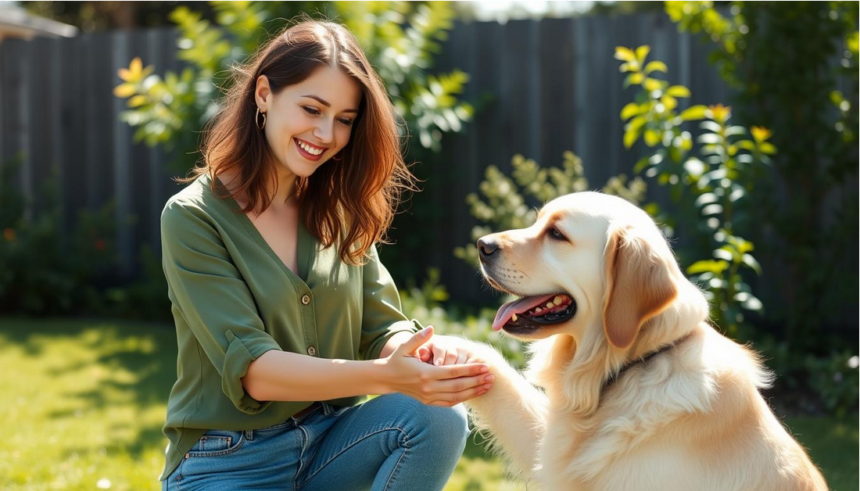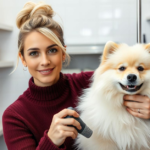India customers to view on amazon.in
“Please note that no animals were harmed in the making of this content.”
Top 5 Fun Tricks to Teach Your Dog
Teaching your dog new tricks is a great way to strengthen your bond and provide mental stimulation. With simple steps and positive reinforcement, you can help your furry friend become a well-behaved and obedient companion.
- The Benefits of Teaching Your Dog New Tricks
- Getting Started: Training Essentials
- Choosing the Right Treats and Rewards
- Creating an Ideal Training Environment
- Understanding Positive Reinforcement
- Top5 Fun Tricks to Teach Your Dog
- Trick #1: Shake Paws/High Five
- Step-by-Step Training Instructions
- Troubleshooting and Common Mistakes
- Fun Variations: Fist Bump and Wave
- Trick #2: Roll Over
- Trick #3: Play Dead
- Trick #4: Spin in a Circle
- Trick #5: Fetch Specific Items by Name
- Step-by-Step Training Instructions
- Troubleshooting and Common Mistakes
- Expanding Your Dog’s Vocabulary
- Conclusion
- FAQ
- What are the best treats to use for dog training?
- How long does it take to train a dog to perform a new trick?
- Can older dogs learn new tricks?
- How often should I practice dog training?
- What is positive reinforcement dog training?
- How can I mentally stimulate my dog?
- Can I train my dog at home without a professional trainer?

Dog training is not just about teaching commands; it’s about enhancing your relationship with your pet. By learning fun dog tricks, you can create a more engaging and interactive experience for both you and your dog.
Key Takeaways
- Learn simple dog training tips to enhance your bond with your pet.
- Discover fun tricks to teach your dog for mental stimulation.
- Understand the importance of positive reinforcement in dog training.
- Improve your dog’s obedience with engaging training exercises.
- Strengthen your relationship with your furry friend through interactive activities.
The Benefits of Teaching Your Dog New Tricks
Learning new dog training tips can significantly enhance your dog’s mental and physical health. Teaching your dog new tricks is not just a fun activity; it provides a multitude of benefits that can improve their overall quality of life.

Engaging your dog in various canine tricks and pet tricks can have a profound impact on their well-being. It keeps them mentally stimulated and physically active, reducing the likelihood of boredom and related behavioral issues.
Mental Stimulation and Physical Exercise
Teaching your dog new tricks offers mental stimulation, challenging their minds and keeping them engaged. This mental engagement is crucial for reducing stress and preventing cognitive decline. Activities that challenge your dog mentally are considered dog mental stimulation activities, which are vital for their overall health.
| Activity | Mental Stimulation | Physical Exercise |
|---|---|---|
| Learning Tricks | High | Moderate |
| Playing Fetch | Moderate | High |
| Interactive Toys | High | Low |
Strengthening Your Bond Through Training
The process of teaching your dog new tricks strengthens your bond, fostering a deeper connection and understanding between you and your pet. Through training, you establish a line of communication, enhancing your relationship. This bond is built on trust, patience, and positive reinforcement, making your interactions more meaningful and enjoyable.
By incorporating dog training tips into your daily routine, you not only improve your dog’s behavior but also enrich your relationship, creating a more harmonious and loving environment.
Getting Started: Training Essentials
Before you start teaching your dog new tricks, it’s crucial to lay the groundwork with effective training essentials. Successful dog obedience training is not just about the tricks; it’s about creating a strong bond with your dog and ensuring they understand what is expected of them.
Choosing the Right Treats and Rewards
The right treats and rewards are vital in reward-based dog training. Treats should be small, tasty, and easy to consume quickly so your dog can focus on the training. Some popular treat options include freeze-dried liver, small pieces of cooked chicken, or commercial dog treats designed for training.
- Use high-value treats for complex tricks or for dogs that are easily distracted.
- Gradually phase out treats as your dog becomes more proficient in a trick.
- Always reward your dog the moment they perform the desired behavior.
Creating an Ideal Training Environment
An ideal training environment is one that is free from distractions where your dog can focus on you. Minimize distractions such as other pets, family members, or loud noises. Start training in a quiet room and gradually introduce more distractions as your dog becomes more reliable in their responses.

Understanding Positive Reinforcement
Positive reinforcement is a training method where desired behaviors are rewarded, encouraging their repetition. This technique is fundamental to dog behavior training. By focusing on rewarding good behavior rather than correcting bad behavior, you create a positive and enjoyable training experience for your dog.
- Identify the behavior you want to reinforce.
- Reward the behavior immediately.
- Be consistent in your rewards and commands.
By understanding and implementing these training essentials, you’ll be well on your way to teaching your dog new tricks effectively and enjoyably.
Top5 Fun Tricks to Teach Your Dog
Engage your dog with these top 5 fun tricks that are easy to learn and enjoyable for both of you. These dog trick ideas are not only entertaining but also provide mental stimulation and strengthen your bond.
The following tricks have been carefully selected based on their popularity and the joy they bring to dogs and their owners.
How These Tricks Were Selected
The top 5 fun tricks were chosen based on their ease of learning, popularity among dog owners, and the happiness they bring to both dogs and their owners. This selection ensures that there’s something for every dog, regardless of breed or age.
Adapting Tricks for Different Dog Breeds and Ages
Whether you have a young puppy or an older dog, these tricks can be adapted to suit their needs and abilities. For instance, older dogs might need simpler commands, while younger dogs can learn more complex dog commands.
| Trick | Adaptability for Young Dogs | Adaptability for Older Dogs |
|---|---|---|
| Shake Paws/High Five | Easy to learn with positive reinforcement | Can be adapted with simpler hand signals |
| Roll Over | Fun and engaging with gradual training | May require more patience and gentle guidance |
| Play Dead | Enjoyable with step-by-step training | Can be simplified by reducing the number of steps |

Trick #1: Shake Paws/High Five
Teaching your dog to shake paws is a classic trick that never goes out of style. It’s a simple gesture that can be very endearing and is often one of the first tricks dog owners want to teach their pets. Not only is it cute, but it also helps in strengthening the bond between you and your dog.
Step-by-Step Training Instructions
To start teaching your dog to shake paws, you’ll need to begin with basic hand targeting. This involves getting your dog accustomed to touching your hand on command.

Starting with Basic Hand Targeting
Begin by having some treats ready. Hold your hand out flat and let your dog sniff it. As soon as they touch your hand with their nose, say “touch” or “target” and give them a treat. Repeat this process several times until your dog starts to associate touching your hand with the command and the reward.
Tip: Be patient and consistent. It might take a few tries for your dog to understand what you want.
Progressing to the Full Shake
Once your dog is comfortable with hand targeting, you can progress to teaching them to shake paws. Hold a treat above your dog’s paw, and as they lift their paw to reach for the treat, say “shake” and give them the treat. Repeat this until they start to associate the command with the action.
“The key to successful dog training is patience and consistency.”
Troubleshooting and Common Mistakes
One common mistake is not holding the treat correctly, which can confuse your dog. Make sure to hold the treat directly above your dog’s paw so they can easily reach it by lifting their paw.
If your dog is having trouble understanding the command, try breaking it down into smaller steps or practicing in a different environment to keep the training interesting.
Fun Variations: Fist Bump and Wave
Once your dog has mastered the “shake” command, you can teach them more fun variations like a fist bump or wave. For a fist bump, simply close your hand into a fist when giving the command, and your dog will learn to bump their paw against your fist instead of shaking it.
To teach your dog to wave, hold the treat above their paw again, but this time, move it sideways. As they follow the treat with their paw, they’ll naturally make a waving motion.
Remember, the key to teaching cool dog tricks is to keep the training sessions short and fun.
Trick #2: Roll Over
Rolling over is a classic dog trick that not only impresses friends and family but also strengthens your bond with your pet. This fun trick can be achieved with patience, consistency, and the right training techniques.
Step-by-Step Training Instructions
To teach your dog to roll over, start by having them in the down position. From there, use a lure to guide them into a roll. Lure training is particularly effective for this trick as it encourages your dog to follow the treat and learn the motion.
Starting from the Down Position
Begin by having your dog lie down. Hold a treat close to their nose and slowly move it up and over their shoulder, towards their back. As they follow the treat with their head, they should naturally roll onto their back.

Lure training involves using a treat to guide your dog through the desired action. For the “roll over” trick, hold the treat above your dog’s head and move it in a circle towards their tail. As they follow the treat, they will roll over. Reward them with the treat and praise.
Troubleshooting and Common Mistakes
One common issue is not luring correctly, which can confuse your dog. Ensure the treat is moved in a smooth, consistent motion, and avoid pulling it too quickly. Another mistake is not rewarding the dog immediately after they complete the action.
| Common Mistakes | Solutions |
|---|---|
| Not luring correctly | Move the treat in a smooth, consistent motion |
| Pulling the treat too quickly | Slow down the motion to allow your dog to follow |
| Not rewarding immediately | Give the treat and praise as soon as your dog completes the roll |
Adding Verbal and Hand Signals
Once your dog is comfortable rolling over with the lure, it’s time to add verbal and hand signals. Choose a specific command like “roll over” and use it consistently. You can also add a hand signal, such as making a rolling motion with your hand.
“Consistency is key when adding verbal and hand signals. Use the same command and gesture every time you give the command.” – Dog Training Expert
By following these steps and tips, you can successfully teach your dog to roll over, enhancing your training sessions and deepening your bond with your pet.
Trick #3: Play Dead
One of the most entertaining tricks you can teach your dog is to play dead, a classic that never fails to amuse. This trick not only delights family and friends but also provides mental stimulation and physical exercise for your dog.
Step-by-Step Training Instructions
To teach your dog to play dead, start by having them in the down position. From there, you can guide them into the “play dead” position.
Building from the Down Position
Begin by having your dog lie down on command. Once they’re comfortable in the down position, you can start introducing the action of falling onto their side or back. Hold a treat near their nose and slowly move it to the side, towards their shoulder. As they follow the treat with their head, they’ll naturally roll onto their side or back.

To make the trick more convincing, introduce a verbal cue like “bang.” Say “bang” as you lure them into the “dead” position. Repeat this process several times until they associate the command with the action. Gradually phase out the treats, using the command alone.
Troubleshooting and Common Mistakes
A common mistake is not being dramatic enough with the trick. To avoid this, make sure to:
- Use an exaggerated tone when saying “bang.”
- Encourage your dog to stay in the “dead” position for a few seconds before rewarding them.
- Practice regularly to build their confidence and your timing.
Making the Trick More Dramatic
To make the trick more dramatic, you can add flair, such as a dramatic flop onto their side or back. You can also vary the timing, sometimes having them stay “dead” for longer periods before rewarding them. This adds an element of surprise and keeps the trick exciting.
By following these steps and practicing regularly, you and your dog can master the “play dead” trick, making it a fun and memorable activity for both of you.
Trick #4: Spin in a Circle
One of the most engaging tricks you can teach your dog is to spin in a circle, promoting both physical activity and mental stimulation. This trick is not only fun to watch but also provides an excellent way to exercise your dog’s body and mind.

Training Your Dog to Spin
To start training your dog to spin in a circle, you’ll need to use a combination of reward-based dog training techniques and patience. The key is to guide your dog into the desired action using positive reinforcement.
Using Food Luring Techniques
Begin by holding a treat close to your dog’s nose and slowly moving it in a circle. As your dog follows the treat with their head, they will naturally turn in a circle. Be sure to reward them with the treat and praise once they complete a full circle.
Teaching Directional Commands
To add control to the spin, teach your dog directional commands such as “clockwise” and “counter-clockwise.” Start by luring them in the desired direction and gradually phase out the lure, replacing it with the verbal command.
Troubleshooting Common Issues
If your dog is having trouble following the lure or seems confused, try simplifying the movement or using a higher-value treat. It’s also essential to be patient, as some dogs may take longer to grasp the trick.
Adding “Twist” for Counter-Clockwise Spins
Once your dog is comfortable spinning in one direction, you can add variety by teaching them to spin in the opposite direction. Use the same luring technique, and be sure to reward them for their efforts. This adds a fun twist to the trick and keeps your dog engaged.
By following these step-by-step dog training instructions, you can teach your dog to spin in a circle, providing them with a fun and stimulating activity. Remember to keep training sessions short and rewarding to maintain your dog’s enthusiasm.
Trick #5: Fetch Specific Items by Name
Teaching your dog to fetch specific items by name is an advanced trick that requires patience and practice. This trick not only showcases your dog’s intelligence but also enhances their cognitive abilities through positive reinforcement dog training.

Step-by-Step Training Instructions
To start, you’ll need to break down the training into manageable steps. Begin with object recognition, teaching your dog to identify different items.
Starting with Object Recognition
Begin by introducing your dog to various objects, using positive reinforcement when they show interest in or interact with an object. You can start with simple items like a ball, toy, or even a shoe. The goal is to help your dog associate the object’s name with the object itself.
- Introduce one object at a time.
- Use treats and praise to reinforce recognition.
- Repeat the process until your dog can identify the object by name.
Building the Retrieve Command
Once your dog can identify objects by name, it’s time to build the retrieve command. Encourage your dog to bring the item back to you by using verbal cues and rewards.
- Have your dog fetch the item.
- Call them back to you with the item.
- Reward them with treats and praise for successful retrieval.
Troubleshooting and Common Mistakes
One common mistake is not being consistent with the object’s name or the verbal cues. Ensure that everyone in the household is using the same commands and names for the objects.
Some tips for troubleshooting include:
- Revisiting the object recognition phase if your dog is having trouble.
- Using higher-value rewards for more challenging retrievals.
- Gradually increasing the distance and complexity of the retrieval.
Expanding Your Dog’s Vocabulary
Once your dog has mastered fetching a few items, you can expand their vocabulary by introducing new objects. This not only challenges your dog but also makes the training process more engaging.
By following these steps and being patient, you can teach your dog to fetch specific items by name, making it a fun and impressive home dog training trick. This trick is a great example of training your puppy fun tricks that can be enjoyed by the whole family, including kids.
Conclusion
Teaching your dog new tricks is a fun and rewarding experience that strengthens your bond and provides mental stimulation. By following the steps outlined in this article, you can successfully train your dog at home without needing a professional trainer. With patience, consistency, and positive reinforcement, you’ll be well on your way to having a well-behaved and engaged companion.
Try incorporating these cool indoor dog tricks into your daily routine, and watch your dog thrive. Whether you’re looking for dog enrichment ideas or simply wanting to mentally stimulate your dog, these top 5 fun tricks are sure to impress friends and family. With DIY dog training, you can tailor your training approach to your dog’s unique needs and personality.
As you continue to train your dog at home, remember to stay positive and have fun. With time and practice, you’ll be amazed at what your dog can achieve. So why not get started today and discover the joy of dog training at home?
FAQ
What are the best treats to use for dog training?
The best treats for dog training are small, tasty, and easy to consume. Consider using freeze-dried liver, small pieces of cooked chicken, or commercial dog training treats. Choose treats that your dog loves and that won’t fill them up too quickly.
How long does it take to train a dog to perform a new trick?
The time it takes to train a dog to perform a new trick varies depending on the dog’s age, breed, and individual learning pace. With consistent practice and positive reinforcement, most dogs can learn a new trick within a few days to a few weeks.
Can older dogs learn new tricks?
Yes, older dogs can learn new tricks. While older dogs may not be as energetic or have the same level of focus as younger dogs, they can still learn with patience, consistency, and positive reinforcement.
How often should I practice dog training?
Practice dog training regularly, ideally 2-3 times a day, for short sessions of 5-10 minutes. Consistency is key to successful dog training, so make it a part of your daily routine.
What is positive reinforcement dog training?
Positive reinforcement dog training is a method that focuses on rewarding desired behaviors rather than punishing undesired ones. By using treats, praise, and affection, you encourage your dog to repeat the desired behavior, strengthening your bond and promoting a happy, well-behaved dog.
How can I mentally stimulate my dog?
Mentally stimulating your dog can be achieved through various activities, such as teaching new tricks, providing puzzle toys, and engaging in scent work or hide-and-seek games. These activities challenge your dog’s mind, reducing boredom and stress.
Can I train my dog at home without a professional trainer?
Yes, you can train your dog at home without a professional trainer. With patience, consistency, and positive reinforcement, you can teach your dog new tricks and behaviors. Online resources, such as videos and training guides, can also be helpful.







